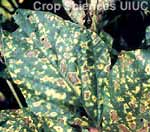Sudden Death Syndrome (SDS)


Symptoms:
- The most commonly observed symptoms are on severely affected leaves, but the primary disease is a root rot.
- Initial symptoms are usually scattered chlorotic spots that occur between the veins on leaves, and the leaves may be cupped or curled.
- These spots typically enlarge between veins to become brown lesions surrounded by chlorotic areas.
- As the disease progresses, the leaves detach from the petioles.
- Roots become rotted and plants may be pulled easily from the ground.
- Gray discolored areas develop inside the root and in the vascular tissue of the lower stem.
- The pith remains white, which is a diagnostic feature that distinguishes this disease from brown stem rot.
Pathogen Involved:
- Fusarium solani f.sp. glycines (a fungus).
- Soybean appears to be the main host of this pathogen, but snap and lima bean may be infected.
- This pathogen overwinters in soil.
Time of Occurrence:
- Infection occurs early in the season, but symptoms usually occur after pods begin filling.
Conditions Favoring Disease:
- Well-fertilized field with high yield potential.
- Early planting.
- Cool, wet soil.
- Soybean cyst nematode infection is often associated.
- Early maturity.
Disease Management:
- Plant soybean varieties with the highest level of tolerance or resistance available.
- Reduce excessive soil moisture with drainage and minimize compacting.
- Manage fields to reduce SCN populations.
- Stagger planting dates.
For more Information on SDS, see the online SDS report.